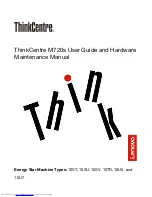
Dell Diagnostics: Dell OptiPlex GX1 Small-Form-Factor System User's Guide
file:///C|/infodev/2013/eDoc/OpGX1/UG/diag.htm[2/21/2013 11:47:14 AM]
Why Run a RAM Test?
Faulty memory can cause a variety of problems that may not, at first glance, appear to be happening in RAM.
If your computer is displaying one or more of the following symptoms, run the subtests in the
RAM Test
Group
to verify that the memory is not at fault:
A program is not running as usual, or a proven piece of software appears to malfunction and you
confirm that the software itself is not at fault. (You can confirm that the software is functioning properly
by moving it to another computer and running it there.)
Your computer periodically locks up (becomes unusable and must be rebooted), especially at different
places and times in different programs.
You get parity errors (any error message that contains the word parity) at any time during operation.
These errors are usually accompanied by a reference to an address—the location of the portion of
memory where the error occurred—which you should record on a copy of the
Diagnostics Checklist
.
System Set Test Group
The subtests in the
System Set Test Group
check the computer’s basic system board components and
verify their related functions.
The subtests that constitute the
System Set Test Group
and the computer functions they confirm follow:
CMOS Confidence Test
Checks the NVRAM for accessibility and reliability of data storage by performing a data pattern
check and verifying the uniqueness of memory addresses.
CMEM Confidence Test
Verifies the accessibility and reliability of the 8 kilobytes (KB) of RAM on the Extended Industry-
Standard Architecture (EISA) Configuration RAM chip, which stores the EISA hardware
configuration information. On systems without flash RAM, performs a data pattern and address
uniqueness test.
NOTE: This test applies only to systems with an EISA bus.
DMA Controller Test
Tests the direct memory access (DMA) controller and verifies the correct operation of its page
and channel registers by writing patterns to the registers.
Real-Time Clock Test
Confirms the functionality and accuracy of the computer’s real-time clock (RTC).
System Timers Test
Checks the timers used by the microprocessor for event counting, frequency generation, and
other functions. Only the functions that can be activated by software are tested.
















































